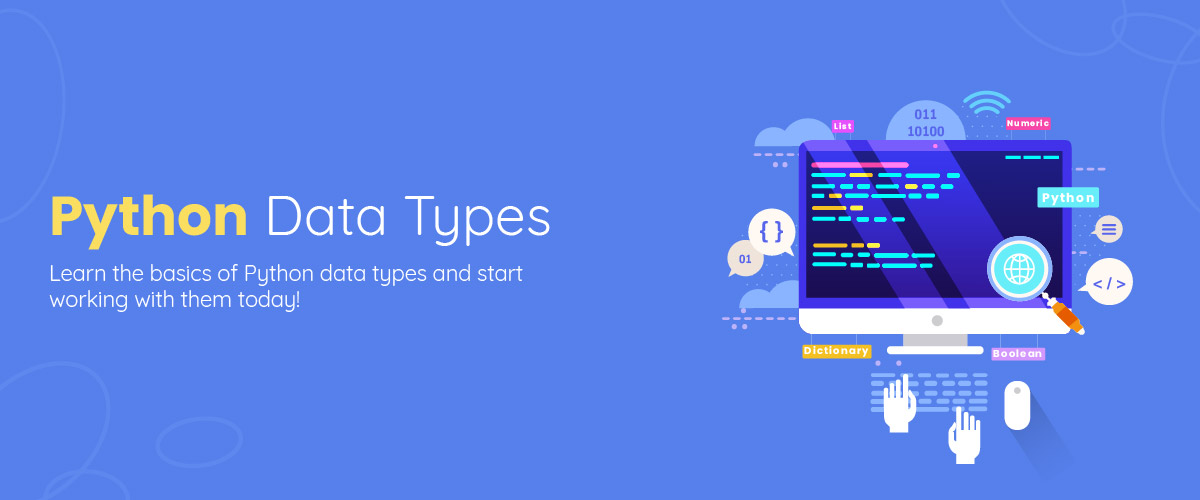Python Data Types: List of Different Data Types in Python With Examples
Developed by Guido van Rossum in 1991, Python is one of the most widely used programming languages in the technical field. Due to its simple and easy-to-use syntax and standard data types, Python finds its application in Machine Learning, Web Development, Artificial Intelligence, and many more fields. This blog will help you understand what are Python data types. We will also discuss the functionality of each data type in Python with examples in detail.
What is a Data Type in Python?
Python data types are referred to as the classification of different data items. It represents different types of variables that inform what operations a user can perform on specific data items. Since everything in the Python programming language is identified as an object, data types are classified as classes and variables as objects of the same classes.
A variable holding a value will always have a data type. With Python being a dynamic type of programming language, there is no need for the users to specify the variable type while declaring it. It is the interpreter who implicitly binds the value of the variable with the data type. Moreover, Python provides the type () function to determine a particular variable’s data type.
For example –
a = 6
The variable in the given example holds an integer value of six, and the data type is not defined. Python interpreter will implicitly interpret the variable ‘a’ as an integer type.
Also Read: What is Python?
Different Data Types in Python
The following are the different data types in Python with examples.
1. Standard or Built-in Python Data Types
As discussed above, a variable can hold multiple values. For instance, Python stores an individual name as a string and its ID as an integer. It provides access to several standard or built-in data types defining the storage method on each of them.
The following are the standard or built-in data types in Python.
- Numeric
- Sequence Type
- Boolean
- Set
- Dictionary
2. Mutable Data Type in Python
The mutable data types are those data types whose values can be changed after creating them. The following are the mutable data types in Python:
- Lists
- Dictionary
- Sets
3. Immutable Data Type
The immutable data types are those data sets whose values can’t be changed after creating them. The following are the immutable data types in Python:
- Numeric
- Strings
- Tuples
If you wish to learn more about Python and its data types, you can take a comprehensive Python course.
4. Numeric Data Type
The numeric data types represent or store the data having numeric values. Python numeric data type can be in the form of an integer, floating values, or complex numbers. Python uses int, float, and complex classes to define these values.
It supports the following listed numeric data types:
* Integers (int)
The numeric data type represented by the int class, integers, includes positive and negative whole numbers, excluding fractions and decimals. In Python, there is no limitation on the length of the integer value. For example, 5, 13, 87, -65, -47, -98, etc.
* Floating Numbers (float)
The numeric data type is represented by the float class, the floating numbers contain real, floating-point numbers. For example, 1.6, 6.65, 43.8, etc. This specific class can store floating-point numeric values up to 15 decimal points.
* Complex Numbers (complex)
The numeric data type represented by the complex class, the complex numbers, contain an ordered pair- x + by [(real part + imaginary part)j]. For example, 3 + 6j, 7 + 5j, etc.
For Example,
value1 = 10
print(value1, 'belongs to the', type(value1).__name__, 'class')
value2 = 5.0
print(value2, 'belongs to the', type(value2).__name__, 'class')
value3 = 2 + 4j
print(value3, 'belongs to the', type(value3).__name__, 'class')
Output -
10 belongs to the int class
5.0 belongs to the float class
(2+4j) belongs to the complex class
5. Sequence Data Type
The sequence data type represents the ordered collection of similar or different data types. With the help of sequence data type, users can store several values in an organized and efficient way.
Python supports the following listed sequence data types:
* String
In Python, strings are a sequence of bytes that represents Unicode characters. A string is typically a collection of one or more characters that a user can put in a single, double, or triple quote. The ‘str’ class represents the string data type in Python.
Now that Python provides built-in functions and operators for performing operations in the string, it becomes easier for you to handle this particular data type in Python.
For example,
// String with single quotes
str1 = 'Welcome to the Mathematics Lecture'
print("String created using Single Quotes:")
print(str1)
// String with double Quotes
str2 = "I'm a Mathematician"
print("\nString created using Double Quotes:")
print(str2)
print(type(str2))
# String triple Quotes
str3 = '''I'm a Mathematics professor in University of California'''
print("\nString created using Triple Quotes:")
print(str3)
print(type(str3))
Output -
String created using Single Quotes:
Welcome to the Mathematics Lecture
String created using Double Quotes:
I'm a Mathematician
<class 'str'>
String created using Triple Quotes:
I'm a Mathematics professor in University of California
<class 'str'>
* List
The list data type is similar to the arrays – an ordered collection of data. This data type is relatively flexible since there is no need for the items in the list to be of the same type. You can create lists in Python simply by putting the items inside the square brackets []. Subsequently, to separate the items stored in the lists, you can use a comma (,).
For example,
// Empty list
my_list = []
print("Initial empty list:")
print(my_list)
// List with a string
my_list = ['TimeAndSpace']
print("\nList with a string:")
print(my_list)
// List with multiple values
my_list = ["Time", "And", "Space"]
print("\nList with multiple values:")
print(my_list[0])
print(my_list[2])
// Multi-dimensional list
nested_list = [['Time', 'And'], ['Space']]
print("\nMulti-Dimensional List:")
print(nested_list)
Output -
Initial empty list:
[]
List with a string:
['TimeAndSpace']
List with multiple values:
Time
Space
Multi-Dimensional List:
[['Time', 'And'], ['Space']]
* Tuple
Similar to the list data type, the tuple data type in Python is also an ordered collection of items of different types. One single difference between these two data types is that tuples are immutable and thus, you can’t modify them after creating the same. The class ‘tuple’ represents the tuple data type. You can create a tuple in Python simply by putting the items inside the parentheses (). Subsequently, to separate the items stored in the tuple, you can use a comma (,).
For example,
// Empty tuple
my_tuple = ()
print("Initial empty tuple: ")
print(my_tuple)
// Tuple with strings
my_tuple = ('World', 'Peace')
print("\nTuple with the use of strings: ")
print(my_tuple)
// Tuple using a list
my_list = [1, 2, 4, 5, 6]
print("\nTuple using a list: ")
print(tuple(my_list))
//Tuple with nested tuples
nested_tuple1 = (0, 1, 2, 3)
nested_tuple2 = ('World', 'Peace')
nested_tuple3 = (nested_tuple1, nested_tuple2)
print("\nTuple with nested tuples: ")
print(nested_tuple3)
Output -
Initial empty tuple:
()
Tuple with the use of strings:
('World', 'Peace')
Tuple using a list:
(1, 2, 4, 5, 6)
Tuple with nested tuples:
((0, 1, 2, 3), ('World', 'Peace'))
6. Boolean Data Type
The boolean data type provides two built-in values, which are ‘True’ and ‘False’. These two values help in determining if the given statement is true or false. Boolean objects that are true are referred to as truthy (true), and false Boolean objects are referred to as falsy (false).
However, Python allows evaluating the non-Boolean objects in the Boolean context and determining whether they are true or false. The class ‘bool’ represents the Boolean data type. A non-zero value or “T” represents the True values, and zero or “F” represents the False values.
For example,
print(type(True))
print(type(False))
print(false)
Output -
<class 'bool'>
<class 'bool'>
NameError: name 'false' is not defined
7. Set Data Type
The set data type is an unordered collection of iterable, mutable, and unique data values. Although the set contains various elements, the order of the elements remains unidentified. You can create the set by using a built-in function set () in Python. In addition to this, a sequence of elements is enclosed in the curly brackets {}, and the comma (,) is used to separate the elements. The set can consist of various types of values.
For example,
// Empty set
set1 = set()
// Set with elements
set2 = {'Maria', 2, 3, 'Python'}
// Printing the set
print(set2)
// Add an element to the set
set2.add(10)
print(set2)
// Remove an element from the set
set2.remove(2)
print(set2)
Output -
{'Maria', 2, 3, 'Python'}
{'Maria', 2, 3, 10, 'Python'}
{'Maria', 3, 10, 'Python'}
8. Dictionary Data Type
In Python, a dictionary data type is an unsorted set of key-value pairs. Informational values can be stored using this data type. The dictionary data type is more efficient because it works like an associative array or a hash table, where each key also stores a value. A colon (:) is used to separate each key-value pair in the Dictionary, and a comma (,) is used to separate each key.
For example,
// Create a dictionary
my_dict = {1: 'Hi', 2: 'Hello', 3: 'Ohayo', 4: 'Bonjour'}
// Print the dictionary
print(my_dict)
// Accessing values using keys
print("1st word is " + my_dict[1])
print("2nd word is " + my_dict[4])
// Print the keys and values of the dictionary
print(my_dict.keys())
print(my_dict.values())
Output -
{1: 'Hi', 2: 'Hello', 3: 'Ohayo', 4: 'Bonjour'}
1st word is Hi.
2nd word is Hello
dict_keys([1, 2, 3, 4])
dict_values(['Hi', 'Hello', 'Ohayo', 'Bonjour'])
Conclusion
This blog covers data types in Python with examples. Numeric data types are integers, float, and complex, while sequence data types are strings, lists, and tuples. Boolean data types have two built-in values (True or False), set data types are unique and mutable, and dictionary data types are unordered sets of key-value pairs. Learning these data types will help you build clean and efficient Python code, allowing your programs to run more smoothly.
FAQs
The three main numeric data types in Python are:
Int: It is a data type for integers value, such as 1, 2, -5, -100, etc.
Float: It stores floating-point numbers up to 15 decimal places, such as 1.99, 19.2, etc.
Complex: It is an ordered pair of complex numbers. For example, 2+4j, 2.5j, etc.
There are five data types used in Python. These are:
1. Numeric (int, float, and complex)
2. Sequence (strings, list, and tuple)
3. Boolean
4. Dictionary
5. Set
Tuple is faster than a list because it can hold more elements with different data types.
No. It is another data type in Python. Set is a modifiable collection of unordered data enclosed within curly brackets, whereas sequence is a series of characters enclosed with quotation marks (single, double, or triple). The sequence data type is of three types – strings, list and tuple.
Yes. The different data types in a Tuple are separated by a comma (,).






